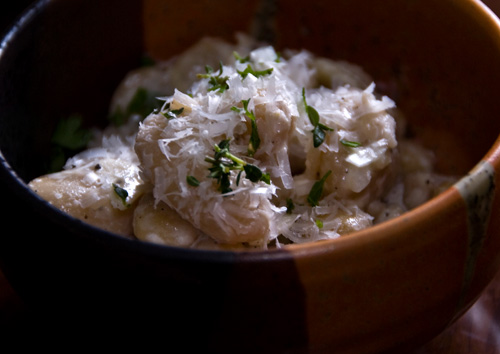Here’s a great recipe that I’ve made several times from my (sort of) new bento cookbook, Yappari Ohiru wa Obento (Of Course, Lunch is Bento). It’s super simple and quick, so I make it when I want a flavorful main dish, but I don’t want to spend a lot of time cooking. If I use two boneless chicken legs, there is enough for dinner for Alex and I and enough leftover for the next day’s lunch. With salad or vegetables and rice, it makes a great meal! The basic recipe is just ume-shu, soy sauce, and chicken, but last time I made it I added one of the ume from the bottle of ume-shu, chopped-up, and a splash of rice vinegar and Alex declared it the best one yet! I am thinking about adding some garlic or shallots next time for a different flavor too.
I use whole, boneless chicken legs for this recipe. You can read my previous post about why I don’t like boneless skinless chicken breasts here. I also read this great article in the San Francisco Chronicle a few weeks ago about chicken thighs as an economical alternative to chicken breasts. If you don’t like dark meat, or prefer chicken breasts, you can substitute them for the legs. Likewise, if it’s difficult to find whole boneless legs at your store, you can use boneless thighs instead. I recommend that you leave the skin on, however, as it adds fat and flavor to the dish, and it looks nice when it’s browned and glazed with the ume sauce.
Ume-shu Chicken
adapted from Yappari Ohiru wa Obento2 boneless, skin-on chicken legs (drumstick + thigh)
2/3 cup ume-shu (Japanese sweet plum wine)
1 tablespoon shoyu
1/2 tsp rice vinegar
1 ume (from the ume-shu), chopped (optional)Trim excess fat and skin from the chicken legs if desired. Heat a large skillet over medium-high heat. When the pan is hot, place the legs in the pan skin-side down, arranging them so that they are evenly thick and not overlapping. Brown the legs on both sides. Drain the excess fat from the pan if there is a lot of it (save this for frying eggs or potatoes if you like). Next, add the remaining ingredients. Cook, uncovered, until the liquid reduces to a syrupy glaze. Flip the chicken a few times to coat evenly with the sauce.
To serve, allow the chicken to rest for 5 to 10 minutes. Slice on the bias. Drizzle with sauce before serving.







